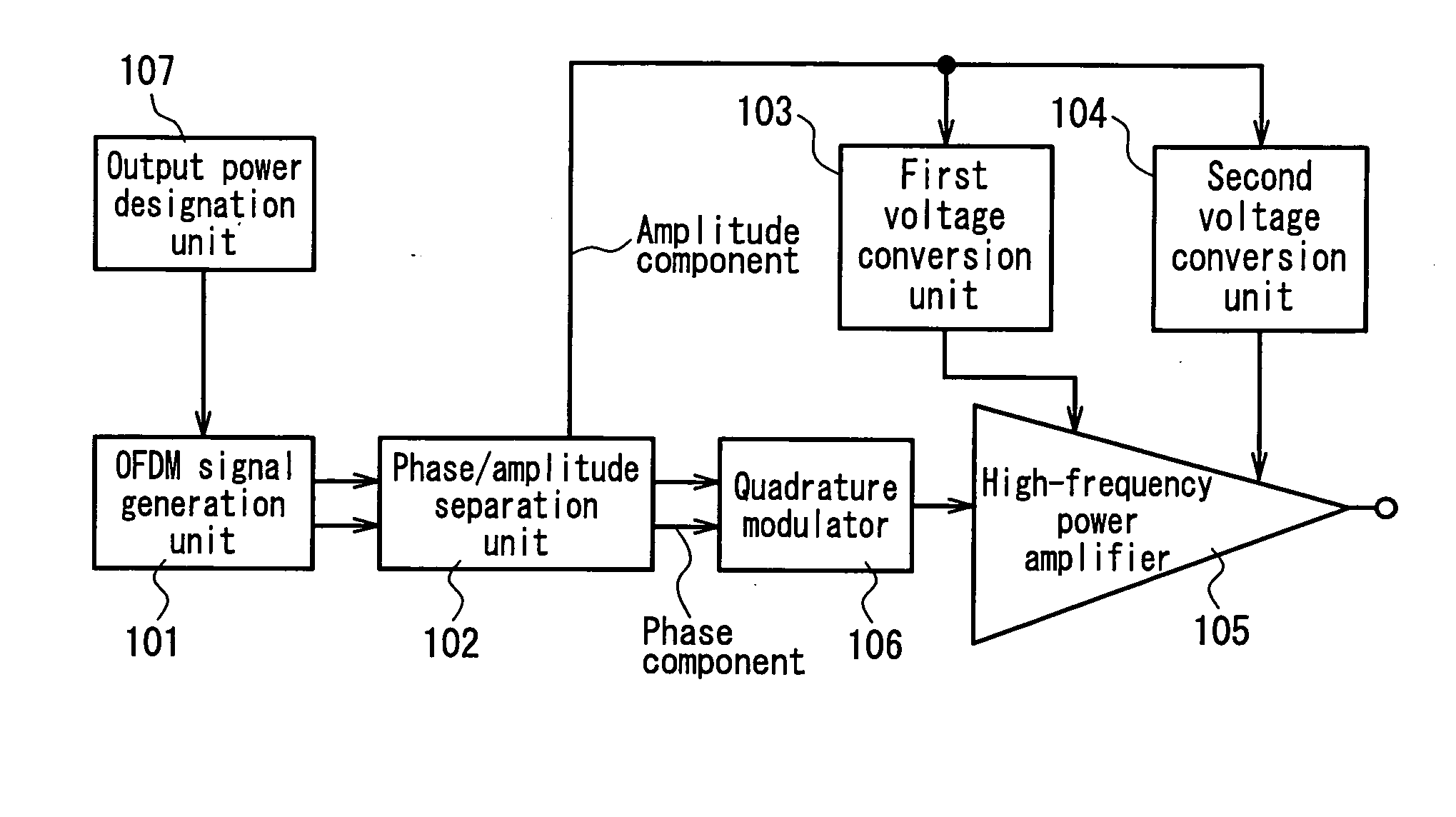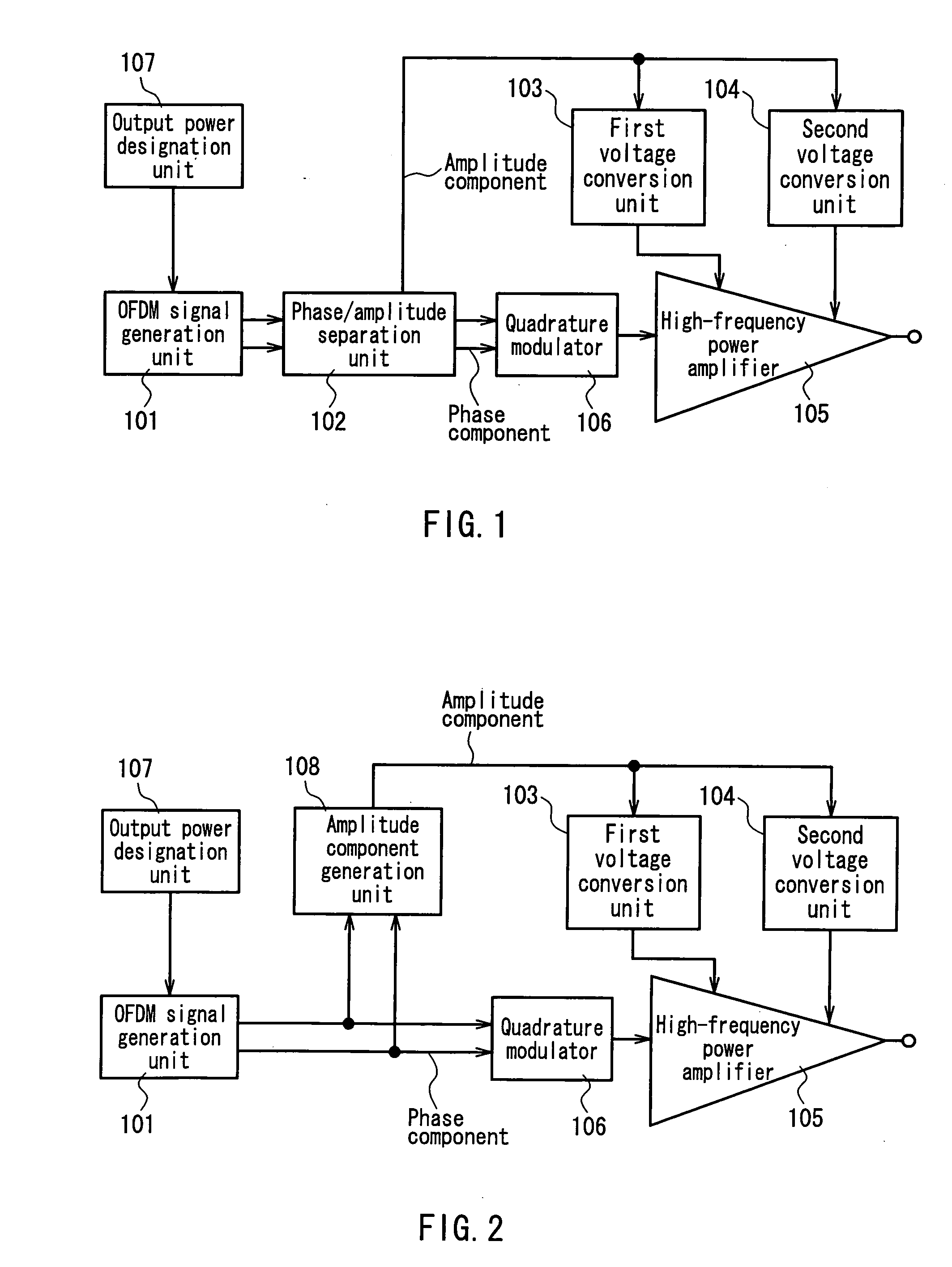Transmitter
- Summary
- Abstract
- Description
- Claims
- Application Information
AI Technical Summary
Benefits of technology
Problems solved by technology
Method used
Image
Examples
embodiment 1
[0033]FIG. 1 is a circuit block diagram showing one exemplary configuration of a transmitter that realizes the EER technique according to Embodiment 1 of the present invention. This transmitter, as shown in FIG. 1, includes: an OFDM signal generation unit 101 as a modulation wave signal generation unit: a phase / amplitude separation unit 102; a first voltage conversion unit 103 and a second voltage conversion unit 104 each receiving an amplitude component from the phase / amplitude separation unit 102 as an input voltage and varying an output voltage level in accordance with a voltage level of the amplitude component; a high-frequency power amplifier 105 having a base terminal or a gate terminal to which an output voltage of the first voltage conversion unit 103 is applied and a collector terminal or a drain terminal to which an output voltage of the second voltage conversion unit 104 is applied; a quadrature modulator 106 as a frequency conversion unit; and an output power designation...
embodiment 2
[0051]FIG. 2 is a circuit block diagram showing one exemplary configuration of a transmitter that realizes the EER technique according to Embodiment 2 of the present invention. Note here that in FIG. 2 the same reference numerals are assigned to the same elements as in Embodiment 1 and their detailed explanations are omitted.
[0052] The transmitter of the present embodiment, as shown in FIG. 2, is different from Embodiment 1 in that a modulation wave signal output from an OFDM signal generation unit 101 is supplied directly to a quadrature modulator 106 and an amplitude component generation unit 108 is used for extracting an amplitude component from the modulation wave signal so as to omit the phase / amplitude separation unit 102.
[0053] According to this configuration, instead of the phase component, the modulation wave signal is used as it is as an input signal of the quadrature modulator 106. Therefore, the deterioration of a modulation accuracy (Error Vector Magnitude: EVM), whic...
embodiment 3
[0061]FIG. 3A, FIG. 3B and FIG. 3C are graphs for explaining a specific exemplary operation of a first voltage conversion unit 103 (FIG. 1 and FIG. 2) of a transmitter according to Embodiment 3 of the present invention. FIG. 4A, FIG. 4B and FIG. 4C are graphs for explaining an operation of a conventional transmitter. In the following description, an operational condition of the conventional transmitter is explained first, and then the operation of the transmitter according to the present embodiment is explained.
[0062] The efficiencies of a high-frequency power amplifier differ as follows depending on the operating classes: under the ideal conditions, the maximum efficiency of the class A operation is 50%, the maximum efficiency of the class B operation is 78.5% and the gain of the class B operation is lower than that of the class A operation by 6 dB. Therefore, consideration is given usually to both characteristics of the efficiency and the gain, and the class AB is selected as the...
PUM
 Login to View More
Login to View More Abstract
Description
Claims
Application Information
 Login to View More
Login to View More - R&D
- Intellectual Property
- Life Sciences
- Materials
- Tech Scout
- Unparalleled Data Quality
- Higher Quality Content
- 60% Fewer Hallucinations
Browse by: Latest US Patents, China's latest patents, Technical Efficacy Thesaurus, Application Domain, Technology Topic, Popular Technical Reports.
© 2025 PatSnap. All rights reserved.Legal|Privacy policy|Modern Slavery Act Transparency Statement|Sitemap|About US| Contact US: help@patsnap.com



